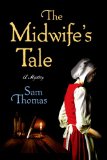Summary | Excerpt | Reading Guide | Reviews | Beyond the Book | Read-Alikes | Genres & Themes | Author Bio

Critics' Opinion:
Readers' Opinion:
First Published:
Jan 2013, 320 pages
Paperback:
Dec 2013, 320 pages
 Book Reviewed by:
Book Reviewed by:
Donna Chavez
Buy This Book
This article relates to The Midwife's Tale
 Hieroglyphics and even cave drawings testify to the fact that from time immemorial women in the throes of bringing forth the next generation have been tended by other women - either trained in the art of delivery or not. From the book of Genesis when Rachel's midwife predicted that she would bear a son (35-17) to Exodus where midwifery was endorsed by no less than God himself (1-20) midwives have enjoyed the privilege of great power. Albeit in a womanly way. What some might call stealth rebellion. Indeed it was midwives who virtually saved the Hebrew nation when they stood up to the Pharaoh's command to kill the Hebrews' newborn sons. So it can be said that Sam Thomas's Bridget Hodgson comes by her uppity disposition naturally.
Hieroglyphics and even cave drawings testify to the fact that from time immemorial women in the throes of bringing forth the next generation have been tended by other women - either trained in the art of delivery or not. From the book of Genesis when Rachel's midwife predicted that she would bear a son (35-17) to Exodus where midwifery was endorsed by no less than God himself (1-20) midwives have enjoyed the privilege of great power. Albeit in a womanly way. What some might call stealth rebellion. Indeed it was midwives who virtually saved the Hebrew nation when they stood up to the Pharaoh's command to kill the Hebrews' newborn sons. So it can be said that Sam Thomas's Bridget Hodgson comes by her uppity disposition naturally.
From ancient times, midwives have been endowed with power and trust within their societies. Religious institutions such as the Catholic Church and secular governmental authorities required midwives to enforce canonical and civil laws. Churches wished to ensure continued growth of their membership by requiring midwives to make certain that newborns would be properly baptized. The interests of governments have also been served by midwives who were expected to pressure an unmarried mother to reveal the child's father so the bastard wouldn't become a ward of the state. In A Midwife's Tale Bridget resorts to withholding services until a single mother in the throes of labor names the child's father. What's more, during eras when men were not allowed in the birthing chamber, women felt free to chat, gossip and even confess their own and their partners' sins. What greater power could an ambitious woman wish to have than knowledge of the sins and secrets of her enemies?
 Churches were the first to license midwives and later, post-17th Century, they were licensed by the state. Licensing had less to do with certifying midwives were properly trained than with keeping tabs on the legitimacy of newborn babies. Eventually midwives themselves began to form membership organizations that promoted education and apprenticeship. However, midwifery began to fall out of favor when the medical profession introduced "painless childbirth" (chloroform) such as that given to Queen Victoria by pioneer physician John Snow. Slowly women opted for physician-attended hospital deliveries over home births with a midwife. This even though prior to the discovery of germ theory there were widespread fatalities in those hospitals.
Churches were the first to license midwives and later, post-17th Century, they were licensed by the state. Licensing had less to do with certifying midwives were properly trained than with keeping tabs on the legitimacy of newborn babies. Eventually midwives themselves began to form membership organizations that promoted education and apprenticeship. However, midwifery began to fall out of favor when the medical profession introduced "painless childbirth" (chloroform) such as that given to Queen Victoria by pioneer physician John Snow. Slowly women opted for physician-attended hospital deliveries over home births with a midwife. This even though prior to the discovery of germ theory there were widespread fatalities in those hospitals.
As the medical profession grew so did the medicalization of pregnancy and childbirth. More and more babies were born in hospitals under the supervision of a physician. In the second half of the 20th century midwifery was generally considered a practice relegated to third world countries. According to the U.S. National Center for Health Statistics, about 44% of mothers gave birth in a non-hospital location in 1940, but by 1969 non-hospital births had fallen to just 1%. This started to change in the 1970s when home birthing held a certain charm for Baby Boomers who were rethinking their parents' institutions. Giving birth at home tended by a midwife or doula has continued to slowly gain favor in the U.S. but still there are less than 30,000 home births each year. Home birthing advocates cite benefits including a more mother-centered experience, health advantages and fewer medical interventions among reasons for its growing popularity. Midwives' organizations have responded by improving opportunities for education and apprenticeships, and improving professionalism. In addition they are aggressively lobbying for more favorable legislation and urging healthy pregnant women to consider home birth with a midwife as a viable option.
It is important to note that midwives and home-births are not synonymous. In fact, the vast majority of midwife-attended births in the USA are in hospitals. In 2010 certified nurse midwives attended almost 8 percent of total deliveries with over 95 percent of these taking place in hospitals. The remainder were split about equally between birth centers and homes.
Some view the growing popularity of midwife-assisted birth as coming full circle while others feel that given the occupation's emphasis on education and professionalism - and the fact that many midwives work in a hospital - it is more a marriage of past and present.
Filed under Cultural Curiosities
![]() This "beyond the book article" relates to The Midwife's Tale. It originally ran in March 2013 and has been updated for the
December 2013 paperback edition.
Go to magazine.
This "beyond the book article" relates to The Midwife's Tale. It originally ran in March 2013 and has been updated for the
December 2013 paperback edition.
Go to magazine.


The Funeral Cryer by Wenyan Lu
Debut novelist Wenyan Lu brings us this witty yet profound story about one woman's midlife reawakening in contemporary rural China.
Your guide toexceptional books
BookBrowse seeks out and recommends the best in contemporary fiction and nonfiction—books that not only engage and entertain but also deepen our understanding of ourselves and the world around us.